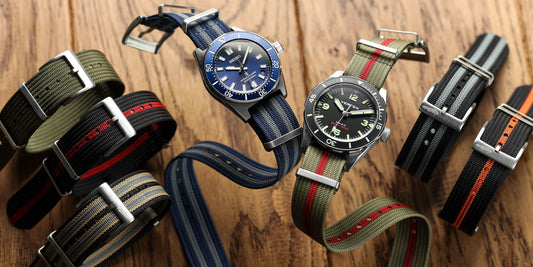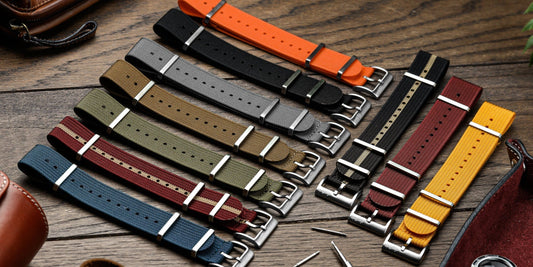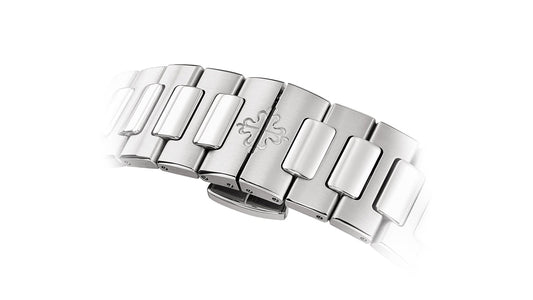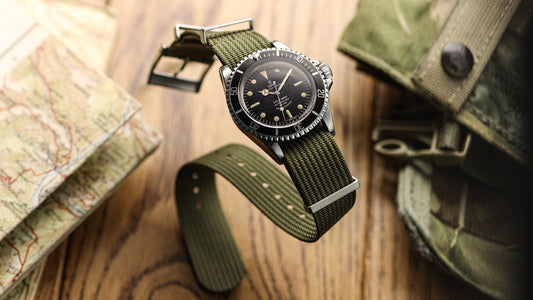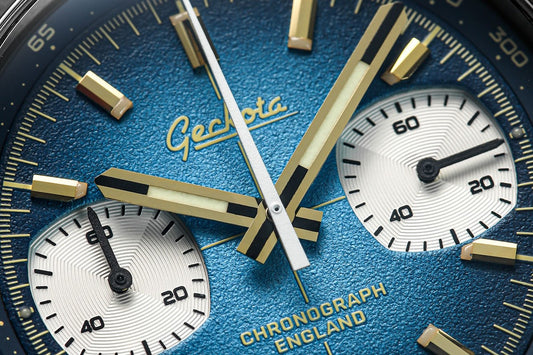Of all the available watch band materials, natural or synthetic rubbers are one of the most versatile and durable. Here’s our introduction to rubber watch straps...
There was a time when a natural rubber strap for watches was an uncomfortably sticky, non-breathable, specialist item with a propensity to crack. Generally, they weren’t the most stylish of watch accessories. But that was decades ago and things change.
Over the last 50 years, a revolution in materials and manufacturing means there’s now a huge selection of high quality, high-performance natural and synthetic rubber watchstraps. Hey, they’re even stylish now, as well as being one of the best watch straps to wear on a dive.
The turning point for rubber watchstraps as luxury accessories was probably in the 1980s when Hublot introduced rubber watchbands (or rubber and metal hybrid straps) to luxury timepieces. So, if you’re ready to get into rubber, here’s our introduction to this most practical, versatile and increasingly stylish of watch band materials...
Rubber Watch Straps – A Brief History
 Omega Seamaster on 1973 British Military Watch Strap: 328 MARINE - Tactical - Credit WatchGecko
Omega Seamaster on 1973 British Military Watch Strap: 328 MARINE - Tactical - Credit WatchGecko
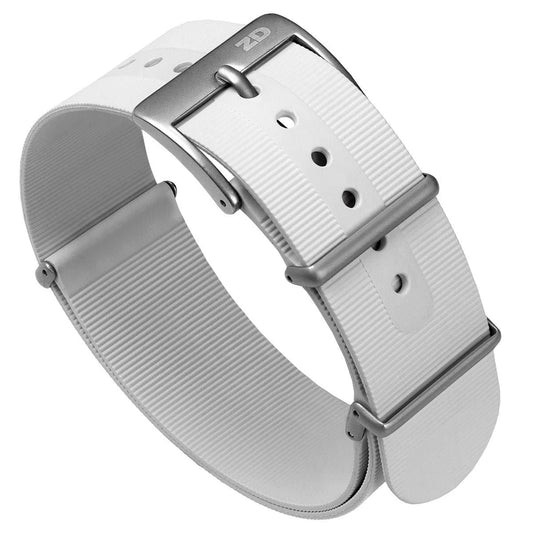

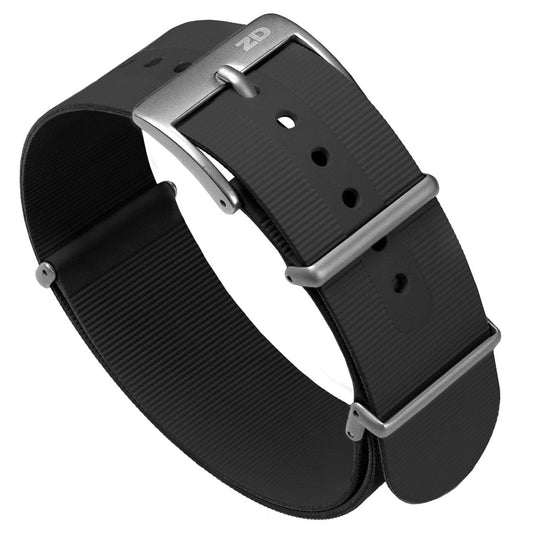
Research including reviewing watch ads in Marco Strazzi’s excellent Watch Ads 1960–2000, reveals that rubber watch straps (initially for divers) entered the mainstream in the 1960s. At the time, quality was variable and many straps were criticised for poor durability and comfort. Others, notably the now-legendary Swiss-made Tropic straps, seem to have endured better.
Tropic straps were initially issued as cheaper (more practical for divers) alternatives to standard metal bracelets on early Rolex and Tudor dive watches, including French Navy Tudor Submariners. Soon, the Tropic became ubiquitous in 1960s and 1970s France – the watch band of choice in certain circles.
As well as the Rolex and Tudor divers, other Tropic-equipped watches of the period included Blancpain’s FF (sold by LIP) as well as LIP’s own Nautic. They also found their way onto other watches with the super-compressor cases patented by Ervin Piquerez SA (EPSA) in the 1950s. The original IWC Aquatimer (1967) also came with a Tropic strap to complement a stainless steel bracelet.
 Omega Speedmaster on WatchGecko 400 (MKII) Italian Rubber Divers Watch Strap - Credit WatchGecko
Omega Speedmaster on WatchGecko 400 (MKII) Italian Rubber Divers Watch Strap - Credit WatchGecko
WatchGecko 400 Italian Rubber Divers Reversible Watch Strap - Navy Blue - Brushed / Polished
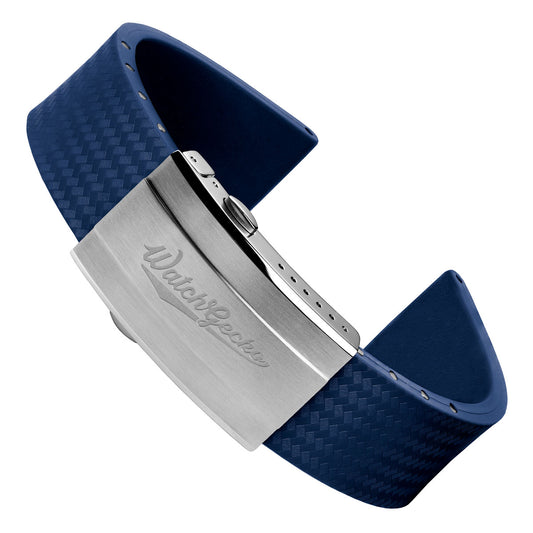
WatchGecko 400 Italian Rubber Divers Reversible Watch Strap - Orange - Brushed/Polished

Rubber straps gained popularity in the 1970s and 1980s. Watches such as the Precimax Super-Dive and Aquastar Benthos 500 appeared on rubber – usually black rather than the bright blue, orange or yellow rubber watch strap so often seen today. As the trend gained further momentum, watches such as the 1990’s IKEPOD and Audemars Piguet Royal Oak Offshore, 2006’s Eterna KonTiki Diver, Vulcain’s Nautical Calibre V-10 and Glycine’s Lagunare LCC 1000 followed suite.
In the 1980s, Italian manufacturer Bonetto Cinturini came onto the watchstrap scene. Since then, they’ve developed into one of the – if not the – leading makers of rubber watch straps. Whether you want a tyre-tread-textured black strap or an unmissable orange rubber watch band, they’re among the top manufacturers supplying luxury Swiss watch brands as well as microbrands like ours. Discover our collection of Italian rubber watch straps today!
Nowadays, the brochure of any self-respecting dive or sports watch manufacturer will include rubber strap options. From Breitling’s Superocean Héritage to Carl F. Bucherer’s Patravi Scubatec and Eberhard’s award-winning Scafograf 300, rubber straps feature prominently. However, rubber watch straps aren’t just for the water, as Chopard has proven since the 1980s with its motorsport-inspired Mille Miglia watches. Several of these periodically updated watches have been supplied on rubber straps that faithfully reproduce the distinctive tread patterns of classic 1960s Dunlop racing tyres.
Different types of Rubber Watch Straps
This isn’t going to be a deep lesson in the chemistry and physics of natural and synthetic rubber. There are many better sources of information by experts who are infinitely more qualified to discuss the subject. But from the watch strap perspective, it’s worth quickly summarising the main types of ‘rubber’ that you’ll encounter.
 NTH on WatchGecko Curved Ends Blue Rubber Watch Strap - Credit WatchGecko
NTH on WatchGecko Curved Ends Blue Rubber Watch Strap - Credit WatchGecko
- Regular price
- $144.00 AUD
- Regular price
-
- Sale price
- $144.00 AUD
- Unit price
- per
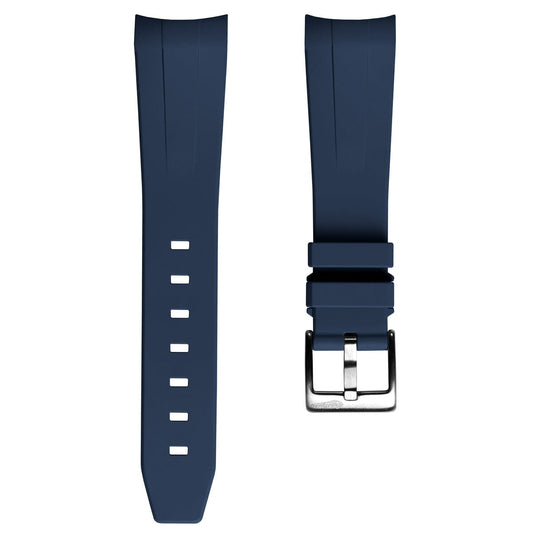
- Regular price
- $144.00 AUD
- Regular price
-
- Sale price
- $144.00 AUD
- Unit price
- per

- Regular price
- $144.00 AUD
- Regular price
-
- Sale price
- $144.00 AUD
- Unit price
- per
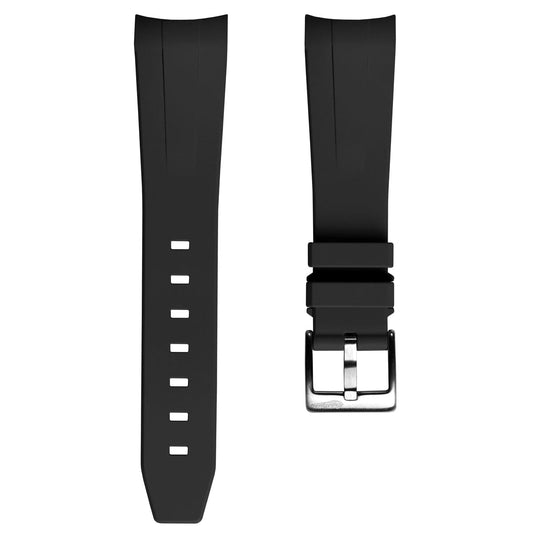
Natural rubber
As we’ve seen, many of the early natural rubber straps didn’t perform brilliantly. Nowadays, however, the vulcanised nitrile rubber watch strap is one of the most popular and widely used for high-performance applications. As with any rubber, its performance isn’t just determined by its type, be it Nitrile Butadiene Rubber (NBR), silicone rubber, polyurethene rubber or PVC rubber. Also important is the specific formulation and processing by manufacturers such as Bonetto Cinturini.
Silicone rubber
This is a rubber-like material that seems to be less widely used for serious high-quality performance watch straps – with notable exceptions such as Sinn, who offer silicone rubber straps on models as diverse as their duo-chronograph and U200 (EZM 8) mission timer. While silicone can easily be shaped and coloured, it has a reputation for stickiness, a tendency to tear and propensity to attract dust and lint.
PVC rubber
Shinier than polymers like PU rubber, this is a thermoplastic vinyl polymer that’s very durable, but lacks the characteristics for high-end applications that make NBR so appealing.
 Hamilton Khaki on WatchGecko Vintage Tropical Style FKM Rubber Watch Strap - Credit WatchGecko
Hamilton Khaki on WatchGecko Vintage Tropical Style FKM Rubber Watch Strap - Credit WatchGecko
PU rubber
Polyurethene rubber (‘urethene’) is another polymer with elastic properties – an elastomer – comprising a chain of organic units linked by urethene (carbamate) links. They are very durable, highly functional, but sometimes reported to be less comfortable than natural rubber.
FKM
Fluoroelastomer rubber, commonly referred to as FKM, is a synthetic rubber known for its exceptional resistance to heat, chemicals, and wear. This versatile material is widely used across various industries, including aerospace, automotive, and oil and gas.
Others
Over the years, other synthetic rubbers have been produced from petrochemical bases, including isoprene and neoprene. Both have specialist following. In particular, isoprene straps enjoy a good reputation, but at a price that’s several times more than a top-quality vulcanised rubber watch strap.
Benefits of Rubber Watch Straps
 ZULUDIVER 284 Italian Rubber Diver's Watch Strap Range - Credit WatchGecko
ZULUDIVER 284 Italian Rubber Diver's Watch Strap Range - Credit WatchGecko
First, we must restate that within any of the main ‘rubber’ types, additives, composition, usage, exposure to the elements, personal preference and time are among the factors determining the performance, comfort and durability of straps. Despite criticism of some 1960s rubber straps, genuine Tropic straps appear to have proved relatively durable. Occasionally, they even surface as new-old-stock (NOS) straps – albeit at a premium reflecting their provenance and scarcity.
The following summarises the characteristics that make a rubber strap for watches so appealing for diving, sports and general leisure use – and as a luxury watch accessory. One style commentator writes: ‘That rubbery, straplike thing that holds the new Rolex Oyster Perpetual Yacht-Master Everose Gold on your wrist is not, according to Rolex, “rubber”. Nor is it a “strap”. It is, in the company’s description, an Oysterflex, a “technical bracelet”.’ Rubber watch straps have firmly established themselves as must-have accessories for the more exotic watch bands!
- A waterproof watch strap (fresh and saltwater).
- Durability.
- Resistance to UVA radiation.
- Availability in a wide range of colours and textures.
- Non-allergenic and non-toxic.
- It’s easy to clean a rubber watch strap.
- Electrical non-conductivity.
- Generally unisex: women’s and men’s rubber watch straps aren’t generally differentiated.
- Secure fitting and wide adjustability.
- Suppleness and expandability.
- Low cost and cheaply replaceable if lost/damaged.
- Lightweight compared to steel bracelets.
- Stylish.
- Scratch-resistant.
- Vanilla scented (Bonetto Cinturini).
With properties such as these and the practicality, comfort, security and durability they bestow, it’s no surprise that rubber watch straps are so popular.
Which rubber strap is right for me?
 Seiko Willard on 1973 British Military Watch Strap: 328 MARINE - Tactical - Credit WatchGecko
Seiko Willard on 1973 British Military Watch Strap: 328 MARINE - Tactical - Credit WatchGecko
- Regular price
- $144.00 AUD
- Regular price
-
- Sale price
- $144.00 AUD
- Unit price
- per

- Regular price
- $144.00 AUD
- Regular price
-
- Sale price
- $144.00 AUD
- Unit price
- per

- Regular price
- $144.00 AUD
- Regular price
-
- Sale price
- $144.00 AUD
- Unit price
- per

As ever with watches and watch accessories, choosing between different types of watch straps involves several variables. Whether you eventually choose natural NBR rubber or a synthetic polymer rubber, your strap choice will reflect how you’ll use it and your personal preferences. Fancy bright colours and ‘cheap and cheerful’ for occasional leisure use? Then maybe a cheap silicone wrist watch band will suffice. But if you work as a diver in subsea engineering, you’ll want the best dive watch strap you can buy – a strap that’s durable and comfortable for prolonged wear. In that case, a PU, isoprene or Italian Bonetto Cinturini strap is more likely to meet your needs.
And what about your watch type? A modern Sinn or TAG Heuer Aquaracer will look stunning on a contemporary deployant strap. On the other hand, vintage Omegas or Breitling Superoceans will probably better suit a Tropic strap. If you’re fortunate, this may be an original. More likely it will be a contemporary Tropic reproduction costing a fraction of the Swiss-made original.
Like modern Military style straps, the good thing about the latest rubber watch bands is their affordability. This means you can afford to experiment with different watch types and styles. Well, maybe not with luxury brands’ signed versions, where a Rolex, Breitling or Omega rubber watch strap will cost a small fortune… But you certainly can with microbrand straps, which are much more affordable than the luxury brands’ straps (many of which are, in any case, made by the same manufacturers).
So what’s it going to be?
A bright orange rubber watch strap with a clasp?
How about putting a reversible ZULUDIVER 400 with stainless steel deployment clasp on your Seiko 5 Sports watch? Or maybe you want the practicality of an Italian Rubber Military Strap to replace the uninspiring Japanese OEM rubber? Or an authentically reproduced Tropic-style strap for your treasured Submariner – for a fraction of the price of an original example of one of these now-rare vintage watch straps!


